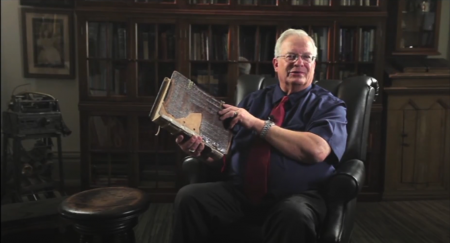One invaluable resource that researchers of William Bradford have is an inventory of his goods taken after his death. While we have some omissions to complain about, like the titles of the “three and fifty smale books,” there is much to make use of. One entry that stands out is “2 bibles.”1 The Bible, of course, was the foundational book for the Pilgrims, the one on which they based their entire lives. It is entirely appropriate that this is the only book recorded of which Bradford had two copies.
Quite a lot is known about one of these Bibles, as it has actually survived. It is on display today in the Pilgrim Hall Museum in Plymouth. It is a well worn copy of the Geneva Bible, published by Christopher Barker, who held the patent to print the book from the government, dated 1592.2 It is possible that the information on this title page is false. Once the authorized King James Version was translated in 1611, the government encouraged printing of only that translation. Demand was still high for the Geneva translation, such copies were printed in places like Amsterdam with a false date, such as 1599, to avoid any legal issues.3 If the imprint date is accurate, Bradford must have obtained it used, as no matter how remarkable a boy he may have been, he would not have been buying a Bible at the age of two.

So much for one Bible, but what might we know about the other? There are reports out there that it also exists. In a 2016 interview, Brent Ashworth, a Mormon historic document collector from Utah, talks about a “Calvin Bible” that he owns. He says that it was a New Testament, signed by Bradford on the title page and partly on the board, which he brought on the Mayflower.4 There’s a couple issues with this. There was no “Calvin Bible.” John Calvin did not speak English. The Geneva Bible, translated in his city under his influence, is the closest thing there could be to a Calvin Bible. There’s also no way to know what Bradford brought with him on the Mayflower, as the inventory of his possessions is from almost four decades later. A short video interview with Ashworth helps us makes sense of what he has. It is actually no Bible at all, but a Dutch translation of Calvin’s commentaries on all the Epistles of the Apostle Paul, published in Leiden in 1601.5 This does show up obliquely in his inventory, as “Calvine on the epistles in Duch with Divers other Duch books.” This is a very remarkable artifact, but not one of his two Bibles.

Even though that is not his second Bible, there are some things that we know, or can guess, about it. His inventory gives the value of the two Bibles together as one pound sterling. I’ve seen it said that the surviving Geneva Bible would have been less than half that, so the other one would have been significantly more valuable.6 Another intriguing possibility is that it was a King James Bible, not a Geneva. The Geneva Bible is normally thought of as the Bible of the Pilgrims. In fact, it has been called the “Pilgrim’s Bible.” This has some truth to it. It took a long time for the Authorized Version to overtake the Geneva in popularity, considering the suspicion of the Puritans regarding its origins with the anti-Puritan King James. It may surprise some to learn that the Pilgrim John Alden owned a King James along with a Geneva at his death.7 If you check the scripture quotes that Bradford uses in his writings, you will find that a few of those contained in his later writings seem to come from the King James version instead of the Geneva.8 He may have had two Bibles so that multiple members of the family would be able to read it at the same time. One the other hand, it would also make more sense for him, Hebrew scholar as he was, to purchase a second copy of the Bible in the other major translation so that he could compare them to try to get as close as he could to understanding the original meaning.
We may never know for sure, but it is possible that his missing Bible may have been from King James. Bradford fled first to Holland, then to the New World, to escape the religious regime of this very king.
References
1. “Governor William Bradford’s Will and Inventory” by George Ernest Bowman in The Mayflower Descendant. vol. 2. Boston: Massachusetts Society of Mayflower Descendants, 1900. p. 228-234.
2. “Four Early Bibles in Pilgrim Hall” by Charles C. Forman in Pilgrim Society Note series 1, no. 9, April 1959; A History of European Printing by Colin Clair (New York: Academic Press, 1976), p. 268-269. As quoted by Notes on Christopher Barker.
3. Bible: The Story of the King James Version, 1611-2011 by Gordon Campbell (Oxford: Oxford University Press, 2010) p. 113.
4. “Collector has Bradford Bible from Mayflower” Scott Fisher interview with Brent Ashworth on Extreme Genes ep. 122, podcast transcript, January 18, 2016.
5. “History Geek – 1601 Calvin Bible” by The History Geek on Youtube, published June 27, 2017.
6. William Bradford’s Books: Of Plimmoth Plantation and the Printed Word by Douglas Anderson (Baltimore: The John Hopkins University Press, 2003) p. 273.
7. “Four Early Bibles in Pilgrim Hall” op cit.
8. See History of Plymouth Plantation: 1620-1647 by William Bradford, ed. Worthington C. Ford et al. (Boston: Houghton Mifflin Company, 1912) vol. 2, p. 343 and A Dialogue or Third Conference by William Bradford. ed. Charles Deane (Boston: John Wilson and Son, 1870), p. 57.




